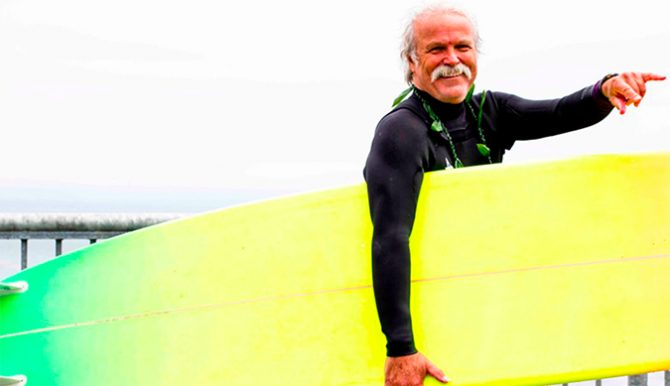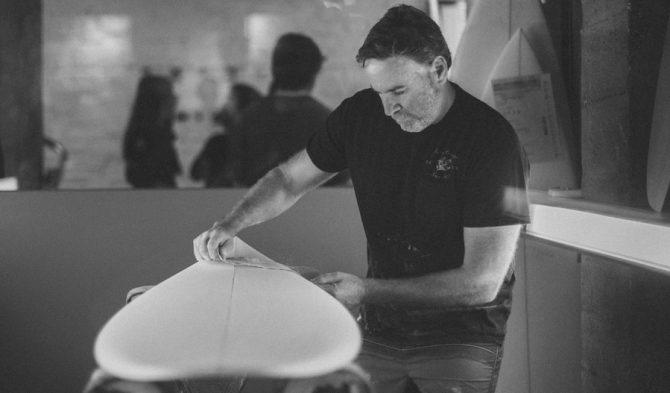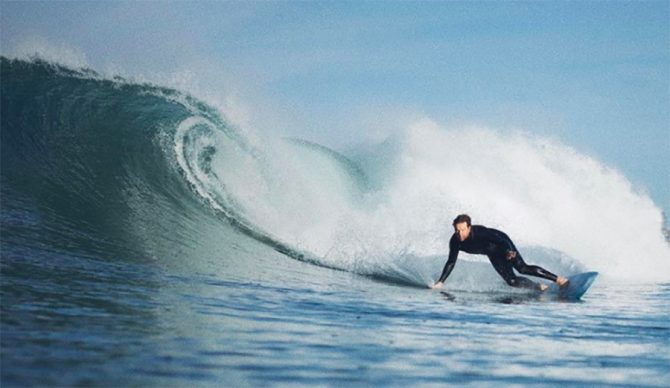
There are a lot of options out there. Where do liters fit in? Photo: Usedsurf
Editor’s Note: Welcome to our new series, “By Design” with Sam George that examines the genius, and sometimes the mystery, of surfing’s storied design history. Sam has been writing about surfing for more than three decades and is the former Editor-in-Chief of SURFER magazine. He won an Emmy for his work on the 30 for 30 documentary, Hawaiian: The Legend of Eddie Aikau. Today, Sam looks at the use of liters in surfboard design.
I recently overheard two intermediate surfers discussing upcoming surfboard acquisitions, both speaking in tones of authority that belied their levels of experience.
“I’m going to go with 39.75,” asserted surfer number one.
“I don’t know,” said surfer number two. “I was thinking about going even lower. Maybe 37.”
No mention of length, center thickness, concave, vee, rail contour or rocker, but just a single measurement that having only recently been introduced to and embraced by the board-buying public has become a kind of magic number, reducing the vast intricacies of surfboard design and associated performance to what appears to be a simple, quantifiable dimension.
I’m talking about liters, the trendy new metric unit that has taken the surfboard market by storm. Though initially introduced way back in 1994 as a component of the first CAD/CAM (Computer Assisted Design and Manufacturing) shaping program developed by Brazil’s Luciano Leao, the measurement remained one of the more arcane aspects of surfboard design until eventually more sophisticated manufacturers like Firewire began adding liter volume to their dimensions. Today, rare is the board that doesn’t include liters in its model description and among a certain board-buying demographic it’s increasingly being pointed to as the most essential standard of performance. Yet while absolutely accurate by nature, do liters actually have much to do with the way any particular surfboard performs? The answer is…well, not as much as one might think.

Bob Pearson of Pearson Arrow Surfboards has thoughts on volume and its distribution. Photo: Surf Masters
First let’s consider what a “liter” is: a metric unit used in measurement of volume, used primarily in measuring liquids, but applicable in this case because the role volume plays in surfboard design. Enter the wonderfully titled “Archimedes Principle,” which paraphrased to our particular needs states that, “a surfboard at rest in a fluid is acted upon by a force pushing upward called the ‘buoyant force,’ which is equal to the weight of the fluid that the surfboard displaces.”
Put simply, the greater the volume, the greater the buoyant force. The greater the buoyant force, the better in the fluid (in this case the sea) the three-dimensional object (in this case the surfboard) will float. However, as buoyant force generally applies only to objects completely submerged in fluid, this means that the liter metric unit designating the volume of your new board will tell you pretty much how well it will float while sitting on it. And that’s about it.
“Liters first started being used in the European sailboard industry back in the 1980s,” explains venerable Santa Cruz shaper Bob Pearson, of Arrow Surfboards. “I thought the idea was absurd back then, but now that the measurement’s made its way into the surfboard market, I know it is. In itself, the liter is 100-percent useless, misleading information.”
Okay then. Yet Pearson’s dismissal of the liter as a salient design measurement isn’t an artisanal statement against exactitude. In fact, just the opposite.
“When it comes to putting a surfer on the right board, the more exact measurements the better,” says Pearson. “By that, I mean length, nose, center and tail width, and center thickness. The combination of these measurements will dictate your board’s overall performance in a way that a single liter measurement can’t.”
Driving this point home, Pearson addresses one of the great fallacies associated with surfboard volume, whether measured in liters or not.
“I have guys coming in to order boards and they tell me they want this exact liter measurement, like 34.6,” says Pearson, suppressing a laugh. “So I ask them why that particular number, and they almost always say, ‘Because I want it to float me.’ So then I ask, ‘Why is floating important?’ ‘Paddle power,’ they say. Then I have to explain that the idea that a thicker board, one with more overall volume, paddles better is false. Sure, you want a reasonable amount of flotation, but the board’s entry rocker is what really determines how well it’s going to paddle. So, do you want to float better, or paddle better?”
Okay, so if the liter volume metric isn’t necessarily a performance indicator, what is?
“What’s more important than any one number is the distribution of volume,” continues Pearson. “You can have two boards with the exact same liter measurement, but if one has a more tapered rail, thinner tail, a more balanced overall foil, it’s going to surf way different, and way better, than the board with the same but less-refined volume. So that’s why those expanded dimensions— length, nose, center and tail width, center thickness and foil — are so essential. Measuring volume in liters is unnecessary.”

Matt Biolos thinks liters is important, especially when it comes to a certain demographic. Photo: …Lost
But hold on a second — not so, says high-performance expert Matt Biolos at Lost…by Mayhem. Yet with a caveat.
“For surfers at the elite level it absolutely makes sense,” says Biolos, who, with surfers like Carissa Moore, Kolohe Andino, Griffin Colapinto, Mason Ho and Yago Dora in his stable, can definitely offer an informed opinion. “Along with length, width and thickness, liter measurement gives you a fourth variable to pinpoint, which lets you really fine tune a board. Because with the types of boards the elite surfers are riding, one liter in volume up or down makes a big difference. So for these types of boards, I believe in it.”
But for those surfers not on the WCT, riding their own models or producing vlogs — meaning the vast majority — getting a new surfboard means a trip to the surf shop, where the average customer will find more and more surfboard brands including, and in many cases highlighting, liter measurement in their model descriptions. According to Devon Howard at Channel Islands Surfboards, for that particular demographic there’s at least one plus in the liter column.
“For someone who hasn’t had a lot of boards the liter measurement can be a helpful tool as a starting point,” says Howard. “But it’s also a blessing and curse. On one hand it gives the customer additional information to make an informed decision with, while on the other end it frustrates manufacturers and surf shop retailers who are trying to inform that customer about all the other variables that go into surfboard design that can’t be quantified by a single number. ”

Mr. Howard, not overly concerned with his board’s volume. Photo: Michael Townsend
Nevertheless, it looks like the liter is here to stay. Mitch Taylor, longtime manager of Becker Surfboards in Malibu, and who admits that up until about five years ago he’d never heard of liters being applied to surfboards, now finds himself interpreting the metric on a daily basis.
“Today pretty much anyone that calls or comes into the shop asks if we have boards with a certain liter measurement,” says Taylor. “That’s why most surfboard brands are now including liters in their dimensions. Which is fine. But the important thing is still talking to the customer and explaining that a lot more goes into picking the right board than how many liters it has. Most of the time I’ll point to my own numbers — length, nose width, center width, thickness — as a starting point and then go on from there.”
Making sure to ask the right questions goes double for the customer. When shopping for a new board, or if you’re lucky enough to talk directly to a shaper, with a better understanding of the role volume plays in surfboard design you might want to leave liters for soft drink bottles, and focus more on the numbers that really add up to a board that rides great.

